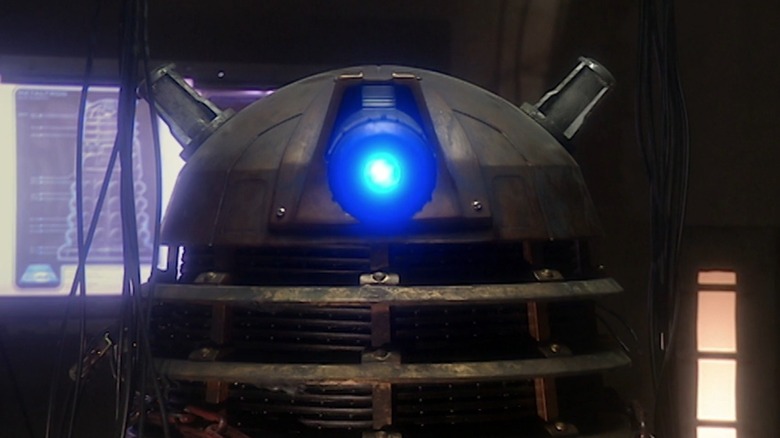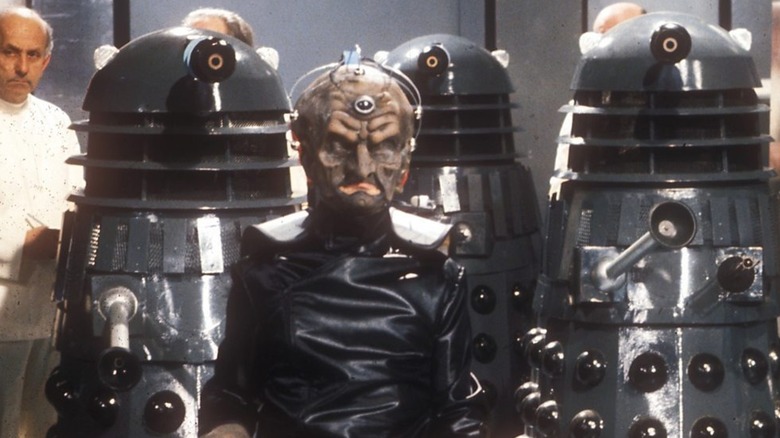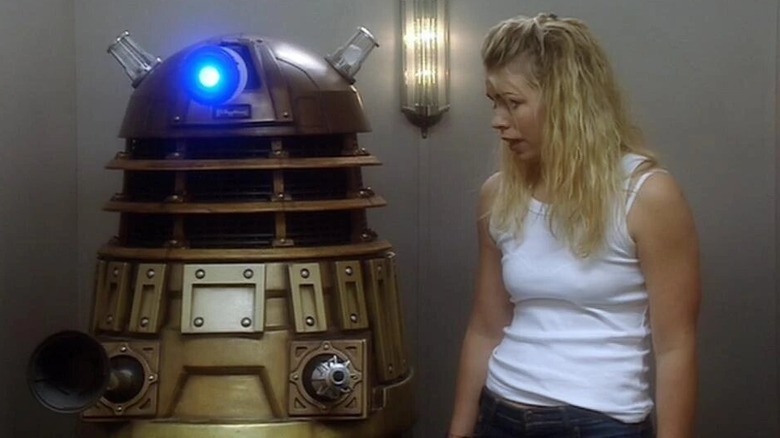What Is A Dalek? Doctor Who's Most Powerful Villains, Explained To New Fans
Anyone who's even remotely familiar with "Doctor Who" probably recognizes the Daleks, the tank-like robotic aliens that want to exterminate the titular Time Lord and everyone else who gets in their way. However, newcomers might not be aware of the villains' true significance, the inspirations that led to their creation, and how they've evolved throughout the years. To help explain the Daleks in "Doctor Who" to new fans, Looper asked franchise expert and superfan Hoai-Tran Bui of the Trekking Through Time and Space podcast for some insights.
According to Bui, the Daleks originated from the imagination of "Doctor Who" writer Terry Nation, who drew inspiration from the Third Reich to create genocidal villains that epitomized true evil. However, behind the scenes, their memorable, militaristic look was created by BBC designer Raymond Cusick, who stepped in for Ridley Scott after the latter focused his attention on directing "Alien," one of the best sci-fi movies of all time. That covers the creatures' real-world background, but the Daleks' in-universe origin story is arguably more interesting due to how demented it is. With that in mind, let's explore the history of these evil rascals and find out what motivates them.
The origin(s) of the Daleks
The Doctor Who franchise has existed for over 60 years, and some of its ideas have been retconned and repurposed to fit with the times. This applies to the Daleks, whose origin story differs depending on which era you want to focus on. As documented by Hoai-Tran Bui, they debuted in 1963's aptly titled serial "The Daleks," where they're portrayed as the mutated survivors of a devastating nuclear war. In this lore, the Daleks put themselves in protective casings to avoid radiation poisoning from the damaged atmosphere on their jungle planet.
However, the villains were given a horrifying reboot in 1975's "Genesis of the Daleks." The story chronicles the eugenic-like atrocities of Davros, a mad scientist from the planet Skaro who turns the entire Kaled race into tank-like monstrosities in an effort to end a war. Unfortunately, he can't control their homicidal nature, and he pays the price for his cruel experiments later on. Chalk this story up as a cautionary tale about the dangers of playing god and trying to create an unholy super race.
Despite the changes to their origin story, Bui notes that the Daleks' core hallmarks have remained the same. "They've always maintained the robotic voice, and the 'giant walking salt and pepper shaker' looks (as they've been called in jest) with eyestalks, and a plunger for a 'manipulator arm' and whisk-like 'gunstick,' though there have been some variations." Unfortunately, some of these slight reinventions haven't always gone according to plan.
The evolution of the Daleks
The Daleks' origin story isn't the only thing that's changed throughout the years on "Doctor Who." While the villains' general look has remained largely the same since their inception, Hoai-Tran Bui highlighted some of their more memorable makeovers, some of which have polarized fans.
"They got a more metallic, worn look with the 'NuWho' relaunch in 2005, in the Season 1 episode 'Dalek.' The show attempted a multicolor makeover in the Season 5 episode 'Victory of the Daleks,' with bigger Daleks that sported bright red, white, blue, and yellow looks, but these proved to be very unpopular and they were immediately walked back. The Jodie Whittaker/Chris Chibnall era from 2018-2022 introduced new black Daleks that had no plunger arm, to much controversy."
The good news, though, is that the botched attempts to spice up the Daleks didn't ruin their rep, as they are some of the most enduring villains in pop culture. As long as "Doctor Who" exists, the likelihood of them returning to try and exterminate everyone is highly likely. However, what is it about the Daleks that makes them so everlastingly relevant and terrifying?
Why the Daleks have endured on Doctor Who
The Daleks are formidable foes who always return to cause trouble for the Doctor and his allies. According to Hoai-Tran Bui, they're practically indestructible, making them effective threats for our heroes to try and overcome time and time again. You can send them to another dimension, but they'll find a way back. However, Bui also believes that their symbolism and horrifying real-world connotations factor into the Daleks' enduring and villainous appeal.
"They want to 'exterminate' anything that isn't Dalek, which makes them pretty patently evil. Their historical inspiration [from Germany in World War II] also lends them a real-world gravity, and taps into the socially conscientious element of sci-fi that makes the genre so powerful. Also they're kind of funny-looking jerks, which always makes them fun to watch."
At the end of the day, the Daleks represent the notion of pure, unadulterated evil. This is a simple theme that can be applied to a variety of contexts and scenarios — and it's why these villains have remained a constant menace in the franchise. As long as there's evil in the world, the Daleks will pack a punch and strike a chord with viewers.
To learn more about the franchise, check out things only true fans know about "Doctor Who."



